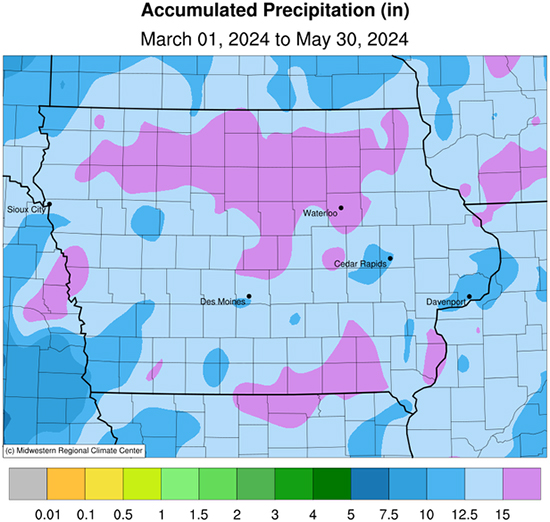Growing Beef Newsletter
June 2024, Volume 14, Issue 12
With likely La Nina development, prepare now to mitigate heat stress situations
Madelynn Wuestenberg, ISU agricultural climatology extension specialist and Grant Dewell, ISU extension beef veterinarian
During June and July, climatologically we expect around 1 inch of rain per week in Iowa. This spring yielded above average precipitation, which helped relieve drought (D1 or greater on the Drought Monitor). Since March 1, 10-15 inches of rain have fallen across the state, leading to ponding in some areas and creating mud for many livestock farmers.

La Nina is likely to develop from July through September, with a 69% chance. During summer, the land and atmosphere become more tightly coupled, and surface moisture availability can play a stronger role on local weather. Because of this influence of local moisture, global climate patterns such as El Nino Southern Oscillation (ENSO) have a weaker signal, and it is more difficult to make forecasts based on long-term climate signals. However, some research has shown that a warming signal can exist over the Midwest during transition years from El Nino to La Nina, such as this year. The Climate Prediction Center's seasonal outlook shows temperatures leaning slightly above average and equal chances for below or above-average precipitation, according to the product issued May 16.
With the forecast for above-normal temperatures this summer, cattle producers need to make sure their heat stress mitigation strategies are ready. Heat stress can reduce feed intake and gain for feedlot cattle, and in extreme heat events, death loss can result. Breeding cows on pasture can see reduced fertility.
Adequate fresh water and shade are the best strategies to reduce the impact of heat stress on cattle. Water consumption will increase by 2-3 times during heat events. Water sources should provide at least 3 inches of linear space per head and have adequate flow to provide about 1.5 gallons of water per hour per head. Limiting availability of water can lead to dominant cattle restricting water access. Shade, either from structures or trees, is important to protect cattle from absorbing heat from the sun. Cattle need about 20-40 square feet of shade per head to allow all animals an opportunity. Other strategies, such as providing good airflow and fly control to decrease cattle from bunching together, also can help cattle cope with heat stress.
Make sure your mitigation strategies are in place and functional now so that cattle will be protected when heat events occur.
This monthly newsletter is free and provides timely information on topics that matter most to Iowa beef producers. You’re welcome to use information and articles from the newsletter - simply credit Iowa Beef Center.
